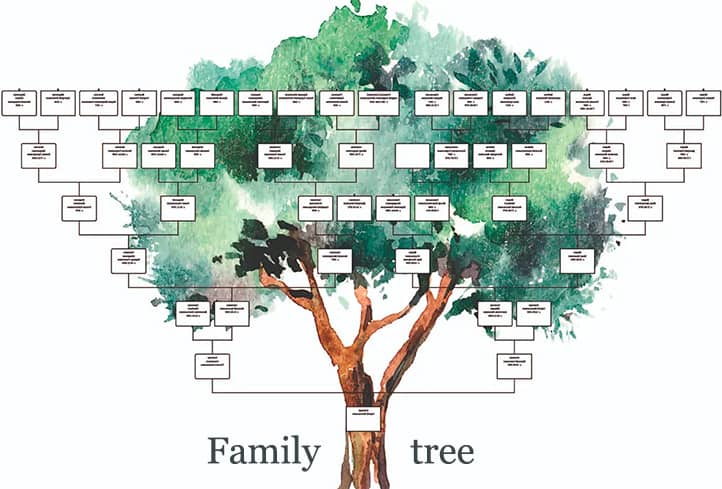The biographical method in psychology is a scientific approach used to study life experiences and personality development. This method analyzes information obtained from various sources, such as autobiographies, diaries, letters, interviews and observations, to assess the historical events and context that influenced the formation of human psyche and behavior.
The biographical method is important in psychology because it allows us to delve into life stories and personal experiences that can explain certain aspects of personality, motivation, and decision-making. It also provides valuable data for identifying patterns in personality development and understanding the influence of sociocultural factors.
The goals and objectives of using the biographical method in psychology can be varied and depend on the specific study. In general, the main goals and objectives of this method include:
- Study of personality development. The biographical method allows you to trace personality changes in different periods of life and determine what factors contributed to these changes.
- Analysis of life events and experiences. Assessing the influence of life events on the formation of psychological characteristics, including motivation, values, attitudes and emotional state.
- Identification of development patterns. Exploration of typical and atypical paths of personality development, as well as comparison of different individual histories to identify general trends.
- Understanding the sociocultural context. Assessing the influence of cultural, social and historical factors on personality development and behavior.
- Constructing and testing psychological theories. The biographical method can be used to confirm or refute existing theories about personality development, motivation and behavior.
- Application in practical activities. Using a biographical approach can assist in psychotherapy, counseling and educational work by providing a deeper understanding of the individual characteristics and needs of clients or students.
- Developing empathy and understanding of others. Learning about other people’s backgrounds helps improve our ability to understand and empathize, which is an important aspect of developing emotional intelligence.

History of the development of the biographical method in psychology
The history of the development of the biographical method begins in ancient times, when people began to record the events of their lives and the lives of others. An important stage was the emergence of psychology as a science in the 19th century, when the biographical approach began to be used to study personality and human development. Philosophers and psychologists such as Wilhelm Wundt and William James began analyzing the life stories of famous people to understand their psychological characteristics.
Contribution of foreign researchers
In the 20th century, the biographical method continued to develop thanks to the contributions of foreign researchers. Significant contributions were made by psychoanalysts such as Sigmund Freud and Carl Gustav Jung, who used biographical data to study mental development and personality formation.
Erik Erikson, a representative of psychoanalytic developmental theory, also made a significant contribution to the development of the biographical approach, proposing his model of the stages of psychosocial development.
The biographical method has also found application in existential and humanistic psychology. Rollo May, Viktor Frankl, and Abraham Maslow used life stories to study human potential, self-actualization, and the meaning of life.
Development of the biographical method in Soviet Union and Ukrainian psychology
In Soviet Union psychology, the biographical method began to actively develop in the middle of the 20th century. The founder of the biographical approach in Soviet Union psychology is considered to be Alexei Nikolaevich Leontiev, who used this method to study the personalities and activities of outstanding people.
In Ukrainian psychology, the biographical method also occupies an important place and is widely used. Ukrainian scientists and psychologists actively developed and used this method, focusing on international and Soviet achievements.
One of the famous Ukrainian researchers who made a significant contribution to the development of the biographical approach is Sergei Rubinstein. He proposed his concept of personal development, which was based on the principle of the unity of consciousness and activity, and also actively used the biographical method to study the relationship between life circumstances and psychological characteristics of the individual.
Today, Ukrainian psychologists continue to develop and improve the biographical method, using it in combination with other research methods and applying it in practice for a better understanding of psychological processes and characteristics of personality development.
In addition, the biographical method is used by Ukrainian scientists in various fields of psychology, such as educational, social, pedagogical and clinical psychology.

Basic approaches to the biographical method in psychology
The biographical method includes a number of basic approaches that define methods for collecting, analyzing and interpreting biographical data:
- The first approach is a selection of autobiographical materials, such as stories, memoirs and autobiographies, which provide a unique opportunity to trace life evidence and the development of individuality through self-expression and self-care Nya.
- Another approach is the analysis of biographies and life stories written by other authors, which allows us to integrate the infusion of current circumstances, sociocultural context and life experiences into psychological development.
- The third approach to the biographical method in psychology is to conduct individual and group interviews with random structures, structured or food-based to collect information about everyday life, Look at the mix of respondents. This approach will ensure a deep understanding of the psychological processes, motives, values and experiences of the participants in the investigation.
- The fourth approach lies in careful analysis of behavior, interaction with others, which makes it possible to identify patterns and features of behavior and the development of features in real life situations.
It is important to note that these approaches can be combined either independently or in combination, depending on the goals and objectives of the investigation.
Narrative approach
The narrative approach is one of the key methods in biographical research and conveys learning characteristics through the analysis of personal stories and evidence. This approach is based on the assumption that individual life can be presented in the form of a sequence of traces that people perceive, interpret and organize in their own knowledge before with the help of narrative structures.
The narrative approach emphasizes how people independently construct their lives, give sense to evidence and ideas, and form their identity on the basis of history and evidence. Within this approach, researchers have focused on analyzing the place, structure, style, themes and symbolic images of narratives, as well as the relationship between narratives and cultural, social, historical and psychological contexts.
To collect narrative data, researchers often conduct virtual interviews, in which respondents are given the opportunity to freely talk about their lives, facts, experiences and views. Such interviews allow for the collection of rich, intimate and emotionally intense material for analysis.
The narrative approach is widely accepted in various fields of psychology, such as social, clinical, educational and educational psychology, as well as in related disciplines, such as sociology, anthropology and cultural studies.
Thematic approach
The thematic approach in biographical research focuses on the analysis of common themes and motives that are present in life stories and personal accounts. This approach can be used to develop different aspects of specialness, social intelligence and psychological development, as well as to identify hidden patterns and differences between different groups and cultures.
A thematic approach provides a systematic analysis of data collected through autobiographies, interviews, case studies, and other methods to identify key themes, categories, and patterns that may be related to due to psychological, social and cultural factors. This analysis process may involve inductive coding, interpretation, alignment and contrasting of data, as well as the development of theoretical models and conceptual frameworks.
The thematic approach may be problematic in various research contexts, such as life transitions, professional development, family dynamics, gender and cultural differences, social mobility, labor migrations and rich others. An alignment of biographical data collected within the framework of various methodological approaches, such as narrative, phenomenological and sociological, may also be useful for analysis.
An important advantage of the thematic approach is its flexibility and adaptability to a variety of research sources, contexts and data, which we add to psychologists, sociologists, anthropologists and others who are involved in biographers. Further investigations.
Genealogical approach
The genealogical approach to biographical research focuses on family history, origins, ancestors, and relationships, as well as interactions between generations. This approach can be used to analyze the influx of family traditions, cultural values, genetic characteristics and historical influences on the psychological development and social behavior of individuals.
The genealogical approach involves the collection and analysis of various data about family history, such as family trees, family archives, historical records, photographs and documents. Investigators can also conduct interviews with different members of the family to obtain information about family connections, mutual families, life stories of ancestors and births, as well as experiences and tell me about the past.
The genealogical approach can be used in various fields of psychology, such as clinical, educational, social and cultural psychology, as well as in related disciplines, such as anthropology, history, demography and genetics . It allows researchers to identify relationships between generations, analyze the influence of family decline on the formation of features and identity, and also understand how genealogical factors interact with our social, cultural and psychological aspects of the lives of individuals.
Case study approach
The case study approach (or the case study method) is one of the popular methods of explicit investigation in psychology, which conveys in detail and depth the behavior of one or more specific situations (individuals, groups, organizations, events) with the method of capturing the great and detailed understanding their features, problems, processes and contexts.
Case studies can be used to analyze various aspects of specialness, social awareness, psychological development and problems, as well as to identify hidden patterns and differences between different types. As part of this approach, the investigators try to isolate as much as possible and accurately the findings about skin lesions, the diversity of data collection methods, such as surveillance, interviews, document analysis, testing, and others.
The peculiarity of the case study approach lies in the fact that it focuses on individual and unique evidence, allows for the development of complex and dynamic processes in their natural context and ensures the ability to generate and new hypotheses, theories and practical recommendations based on specific applications. However, this approach has its limitations, such as the possibility of generalizing results to large groups and the difficulty of standardization and control of the final process.
Case studies are widely used in various branches of psychology, such as clinical, educational, social and organizational psychology, as well as in related disciplines, such as sociology, anthropology, management i marketing.

Techniques for collecting and analyzing biographical data
Techniques for collecting and analyzing biographical data include a variety of methods such as autobiographies, in-depth interviews, observation, document analysis, and genealogical research. Data collection may take the form of oral histories, written recordings, or multimedia materials.
Biographical data analysis typically involves qualitative methods such as narrative analysis, thematic analysis, phenomenological analysis, or genealogical analysis, which allow researchers to identify key events, experiences, images, motives, values, meanings, and patterns in people’s life stories, and to analyze their interrelationships. with psychological, social, cultural and historical contexts.
Autobiographical stories
Autobiographical narratives are collected stories from the lives of individuals, written or told by those individuals themselves. They provide valuable information about the author’s life experiences, personality traits, social connections, values, and worldview. Autobiographical narratives are an important source of data for biographical research in psychology, especially in the context of narrative and thematic analysis.
Collecting autobiographical narratives can take place in a variety of formats, such as written notes, oral interviews, video or audio recordings. Researchers may ask authors specific questions or suggestions to stimulate their recollection and reflection, or give them freedom to choose topics and events to describe.
Analysis of autobiographical narratives may involve a variety of methods and approaches, such as narrative analysis (which focuses on the structure, imagery, and meaning of the narrative), thematic analysis (which identifies key themes, motifs, and categories), or phenomenological analysis (which examines the author’s subjective experiences and perceptions). . Autobiographical narratives can also be used for comparative analysis, contrasting different groups and cultures, or identifying common patterns and differences in people’s life stories.
Biographical interviews
A biographical interview is a method of data collection in which a researcher conducts an in-depth, structured or semi-structured interview with an individual to gather information about their life history, experiences, experiences, values, attitudes and perceptions of the world. This method is an important tool for biographical research and provides insights into the personality traits, psychological processes and social contexts that influence the development and functioning of individuals.
Biographical interviews can be conducted in different formats and with varying levels of structure, depending on the objectives of the study and the preferences of the researcher. During the interview, the researcher may ask open-ended, leading, or specific questions related to various aspects of the respondent’s life, such as family, education, career, relationships, events, values, and experiences.
Analysis of data obtained from a biographical interview may involve various qualitative methods and approaches, such as narrative analysis, thematic analysis, phenomenological analysis, or comparative analysis. Researchers can use these methods to identify key elements, images, motives, meanings and patterns in respondents’ life stories, and to analyze their relationship with psychological, social, cultural and historical factors. Biographical interviews can also be used to generate new hypotheses, theories and practical recommendations based on specific examples and experiences.
Analysis of documents and sources
Document and source analysis is a method of collecting and analyzing data based on the study of written, visual, or multimedia materials that relate to the lives, experiences, activities, and perceptions of the world of individuals or groups. This method can be used in biographical research to complement or deepen information obtained through other methods, such as autobiographical narratives or biographical interviews.
Documents and sources may include a variety of types of materials, such as letters, diaries, autobiographies, photographs, videos, reports, newspaper articles, scientific publications, works of fiction, archival documents and official records. Depending on the goals of the study and the availability of materials, researchers can select and analyze different types of sources that will help them uncover and understand key aspects of the life stories, experiences, values, attitudes, and contexts of their research subjects.
Document and source analysis may include various qualitative methods and approaches, such as content analysis, thematic analysis, narrative analysis, discourse analysis, historical analysis, or visual analysis. Researchers can use these methods to identify key elements, images, motifs, meanings and patterns in documents and sources, and to analyze their relationship to psychological, social, cultural and historical factors. Analysis of documents and sources can also be used to test, confirm or refute hypotheses, theories and results obtained using other methods.
Projective methods
Projective methods are psychological techniques used to study the personality, motives, emotions and attitudes of individuals through the analysis of their reactions to unstructured or ambiguous stimuli. The basic idea of projective methods is that people project their hidden feelings, conflicts and desires onto abstract or symbolic objects and situations, which allows researchers to discover and interpret these internal processes and states.
There are many projective methods, including but not limited to the following:
- Rorschach test. This test asks participants to interpret a series of abstract inkblots to reveal their hidden thoughts, feelings and conflicts.
- Thematic apperception test (TAT). Participants are asked to create and tell stories based on a series of ambiguous pictures, allowing researchers to analyze their motives, emotions and attitudes.
- Tree test. In this test, participants are asked to draw a tree. This drawing allows researchers to assess their self-perception, self-esteem, emotional state and personality traits.
Projective methods can be used in biographical research to complement or deepen information obtained through other methods, such as autobiographical narratives, biographical interviews, or analysis of documents and sources. However, it is worth noting that projective methods are more indirect and interpretive than other methods and may be subject to error, subjectivity, and variability depending on the skills, experience, and preferences of researchers and participants.

Application of the biographical method in practical psychology
The biographical method in practical psychology is an important tool for studying and working with the individual characteristics, experiences, experiences and perception of the world of clients. It allows psychologists to gain a deep understanding of a person’s personality, motivation, needs and values, and to identify the factors that influence their development, functioning and well-being.
The use of the biographical method in various areas of practical psychology, such as personality diagnostics, correctional and developmental work, career counseling and psychotherapy, contributes to the effectiveness and individualization of psychological assistance, as well as to expanding understanding and interaction between psychologists and clients.
In personality diagnostics
The biographical method is used in personality diagnostics to obtain information about an individual’s life experiences, family background, education, career, and social connections. This allows psychologists to assess personality characteristics, attitudes, motives and values, as well as identify possible problems, conflicts or resources that may be associated with the client’s current state and behavior.
In correctional and developmental work
The use of the biographical method in correctional and developmental work allows psychologists to identify areas requiring development or correction and develop individualized programs and techniques that take into account the specific life experiences, needs and goals of each client. The biographical method can also help create positive starting points for self-reflection, self-esteem and self-regulation, promoting personal growth and change.
In career counseling
In career counseling, the biographical method is used to explore the educational and professional experiences, achievements, interests, goals and problems of clients, and to assess their potential, resources and limitations in the context of the labor market and social demands. This allows psychologists to help clients make informed and informed decisions about their careers, development and employment, and develop strategies and action plans to achieve professional and personal goals.
In psychotherapy
In psychotherapy, the biographical method is used to identify and analyze key events, experiences, relationships and conflicts in the client’s life that may be related to his psychological difficulties, symptoms or needs. This allows psychotherapists to better understand the origins, structure and dynamics of the client’s psychological problems, and to develop individualized and targeted therapeutic approaches and techniques to solve or mitigate them.
The biographical method also helps to establish a trusting and empathic relationship between the psychotherapist and the client, deepening their mutual understanding and cooperation, as well as stimulating self-reflection, insight and changes at the level of the client’s thinking, feelings and behavior. This includes working with trauma, family histories, crisis management and internal conflict resolution, as well as supporting and developing the client’s psychological well-being, resources and adaptive strategies.

Examples of successful use of the biographical method in psychology
Examples of successful use of the biographical method demonstrate its wide applicability and significance in various contexts and areas of psychological science and practice. From studies of famous personalities to applications in psychological consultations and cases from the practice of psychotherapy, the biographical method allows for a deeper understanding and analysis of personality traits, stories, experiences and relationships between individuals and their sociocultural context.
These examples illustrate the importance and potential of the biographical method for expanding knowledge of human psychology, improving the quality and effectiveness of psychological care and support, and creating innovative and integrative approaches to the study and development of personality.
Research on famous personalities
The biographical method has been successfully used to study the lives and personal characteristics of famous individuals such as politicians, scientists, artists and athletes. Analyzing their life stories, ups and downs, successes and failures, and relationships with others allows scientists to obtain unique data about the factors that may promote or hinder the development of talent, leadership, creativity and other pronounced qualities.
Here are some specific examples:
- Sigmund Freud and Leonardo da Vinci. The famous psychoanalyst Sigmund Freud used the biographical method to analyze the life and work of Leonardo da Vinci. In Leonardo da Vinci and Memoirs of His Childhood (1910), Freud explores the personality, family background and creativity of the great artist, as well as his attitude towards sexuality and the repression of sexual impulses.
- Erik Erikson and Martin Luther. Psychologist Erik Erikson used the biographical method to study the life and personal development of religious reformer Martin Luther. In his book Young Man Luther: Psychoanalysis and Historical Study (1958), Erickson examines Luther’s life, his relationship with his father and the church, and the formation of his ideology and spiritual leadership.
- Carl Gustav Jung and Richard Wilhelm. Swiss psychologist Carl Gustav Jung used the biographical method to study the life and work of Richard Wilhelm, a German sinologist and translator of Chinese classical texts. In Richard Wilhelm: In addition to the Portrait (1930), Jung explores Wilhelm’s personality, his contribution to the spread of Eastern wisdom in the West, and his influence on Jung’s own understanding of archetypes and the collective unconscious.
- Kate Millett and Simone de Beauvoir. Feminist writer and activist Kate Millett used the biographical method to analyze the life and philosophy of French philosopher and writer Simone de Beauvoir. In Simone de Beauvoir (1981), Millett examines de Beauvoir’s personal and professional relationship with Jean-Paul Sartre, her feminist ideas and influence on the development of the feminist movement, and analyzes de Beauvoir’s contributions to existentialism and literature.
- Robert Greene and Napoleon Bonaparte. Author and power scholar Robert Greene used the biographical method to study the life and success strategies of Napoleon Bonaparte. In his book 33 Strategies of War (2006), Greene analyzes Napoleon’s military and political achievements, his personality, tactics and strategies, and the reasons for his rise and fall.
- Carol Gilligan and Jane Addams. Psychologist Carol Gilligan used the biographical method to study the life and work of American sociologist and activist Jane Addams. In Jane Addams and the Voice of the Ethic of Care (1995), Gilligan examines Addams’ contributions to social work and the creation of social safety nets for the poor and vulnerable, as well as her influence on the development of the ethic of care and feminist psychology.
These examples of research show how the biographical method in psychology can be used to analyze the lives and achievements of famous individuals, identify factors contributing to their success, and study the influence of their ideas and activities on the development of culture, science and society.
Application in psychological consultations
In psychological counseling, the biographical method is used to identify and analyze clients’ problems, fears, motives and goals, and to develop individualized recommendations and coping strategies. Through the collection and analysis of biographical data, psychologists are able to better understand the client’s life experience, establish cause-and-effect relationships and offer the most appropriate and effective methods of help and support.
Cases from the practice of psychotherapy
In psychotherapy, the biographical method is used to work with trauma, long-term psychological problems, family conflicts and other complex issues related to the life experiences of clients. For example, background analysis allows the therapist to identify factors that contribute to the development of depression, anxiety, or addiction, and to develop an individualized treatment plan aimed at overcoming these problems and restoring the client’s psychological well-being.
Cases of the successful use of the biographical method in psychotherapy show its ability to improve the quality and results of the therapeutic process, as well as support changes at a deep level of personality and life attitudes.

Biographical method in psychology: limitations and prospects for development
The biographical method has its limitations and difficulties, including:
- Subjectivity. Biographical data, especially autobiographical data, can be subjective and distorted due to the influence of the experiences, emotions and memory of the narrator or researcher himself.
- Availability and reliability of data. In some cases, especially when studying past events and personalities, researchers may encounter limited access to information or unreliable sources.
- The problem of representativeness. The sample in biographical studies is often limited, which can make it difficult to generalize the study’s findings to the broader population.
Opportunities for further development of the method:
- Triangulation. Using the biographical method in combination with other qualitative and quantitative methods can enhance the validity of the study and compensate for the shortcomings of each method separately.
- Development of data collection and analysis methods. The development of new techniques and tools for collecting and analyzing biographical data may help overcome some of the limitations of the method and improve the quality of the study.
- Interdisciplinary approach. Interaction with other fields of study such as sociology, anthropology, history and linguistics can enrich the biographical method with new ideas, concepts and methods.
Integration with other methods and approaches:
- Combination with methods of sociometry and network analysis. Integrating the biographical method with social network methods can provide new opportunities for analyzing social connections, influence, and structure in individuals’ life histories.
- Use in conjunction with psychometric methods. The use of the biographical method in combination with psychometric instruments such as personality, intelligence, or aptitude tests can enrich research and provide a more complete understanding of individual differences and personal development.
- Integration with cross-cultural research. Collaborating with scholars from different cultural contexts and applying the biographical method to cross-cultural research can lead to new discoveries about the influence of culture on the formation of personality, values, and behavior.
- Connection with neuropsychology and cognitive psychology. Integrating biographical research with neuropsychological and cognitive data can help researchers better understand how life events and experiences influence brain processes and cognitive development.
- Application in conjunction with experimental methods. The use of the biographical method in experimental research can expand our understanding of the interactions between personality, behavior, and the environment, and provide new opportunities for studying mechanisms of change and adaptation.
In general, the integration of the biographical method with other methods and approaches, as well as overcoming existing limitations and difficulties, can contribute to its further development and expansion of its application in psychological science and practice.




